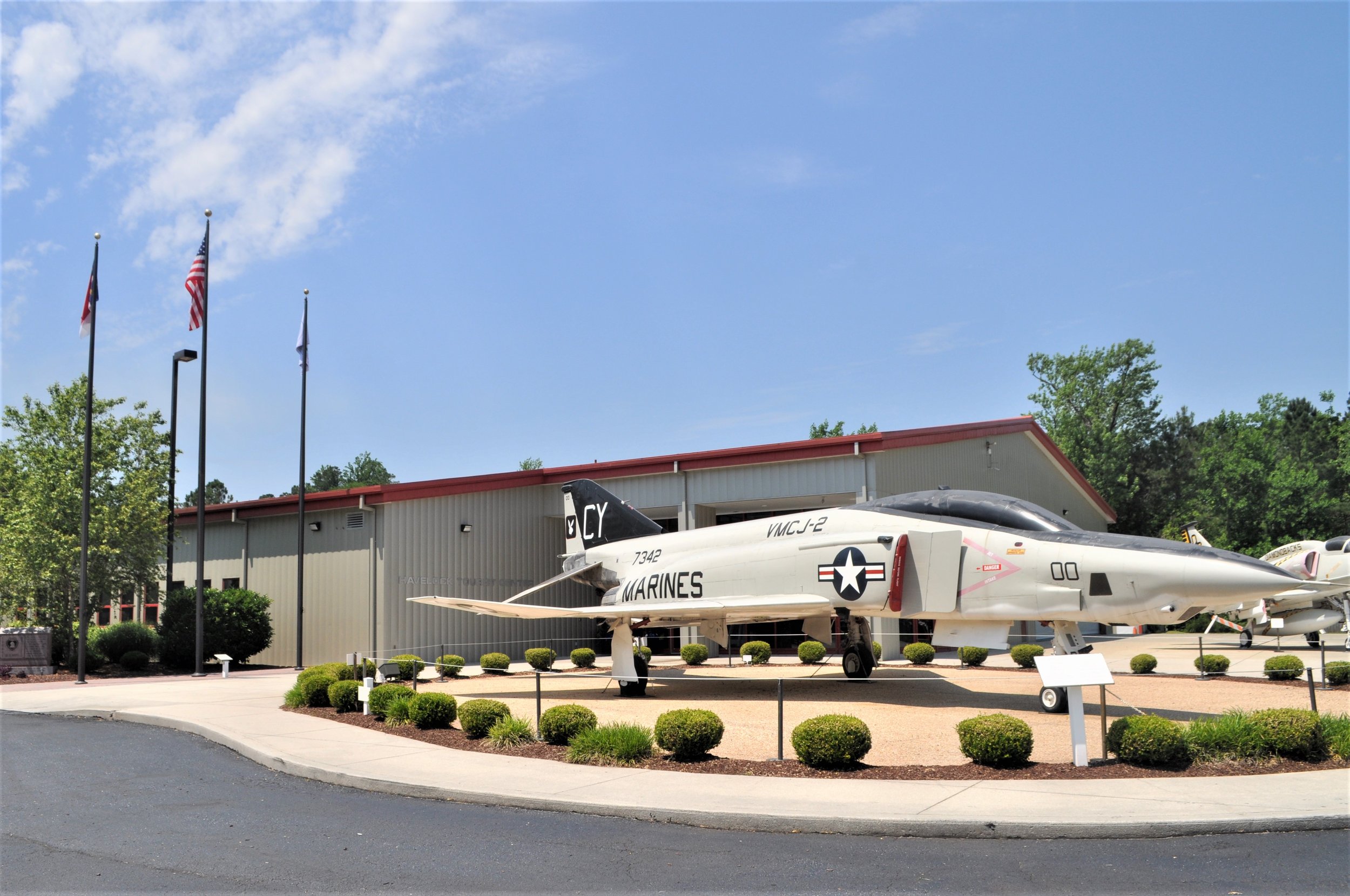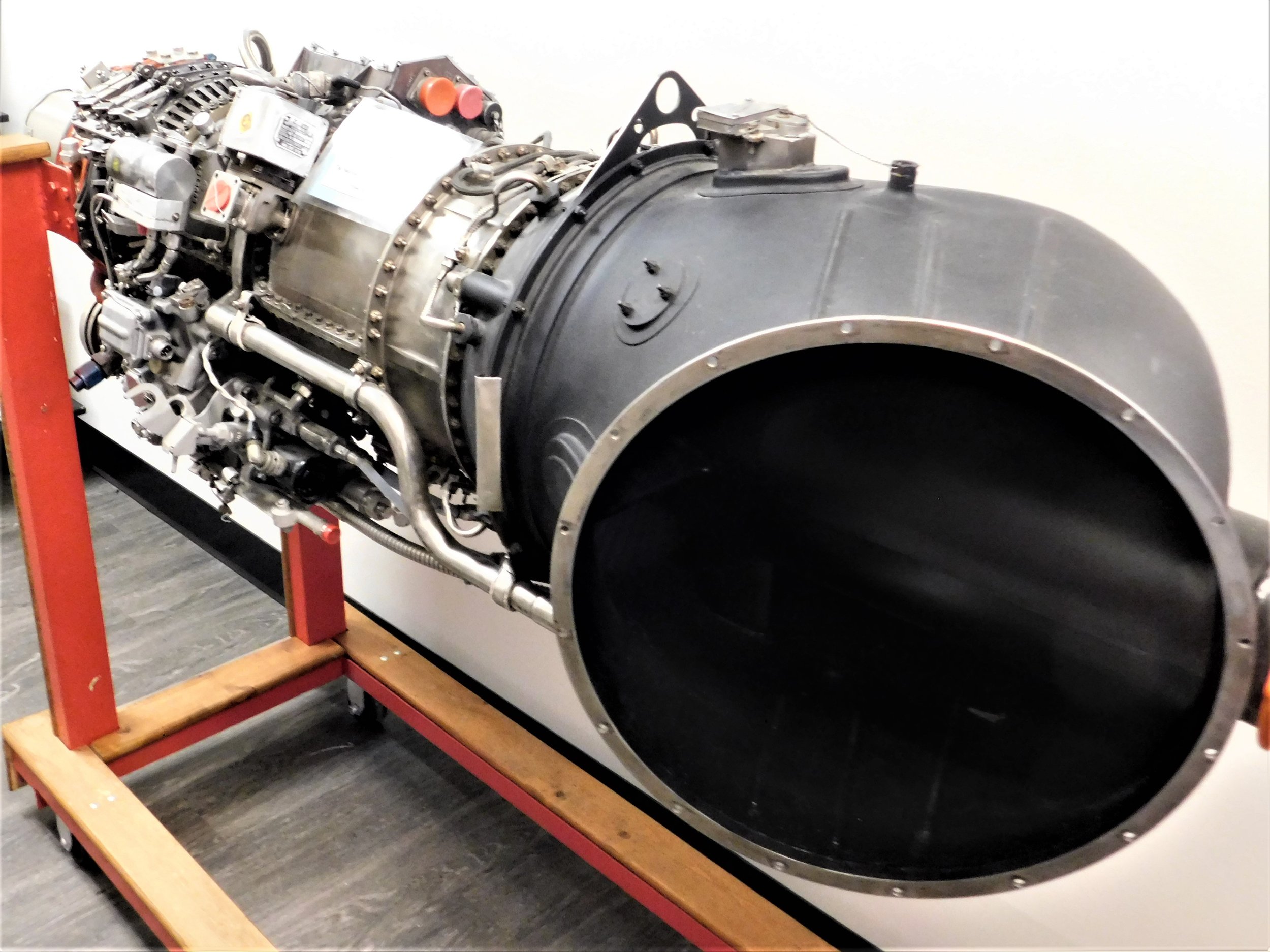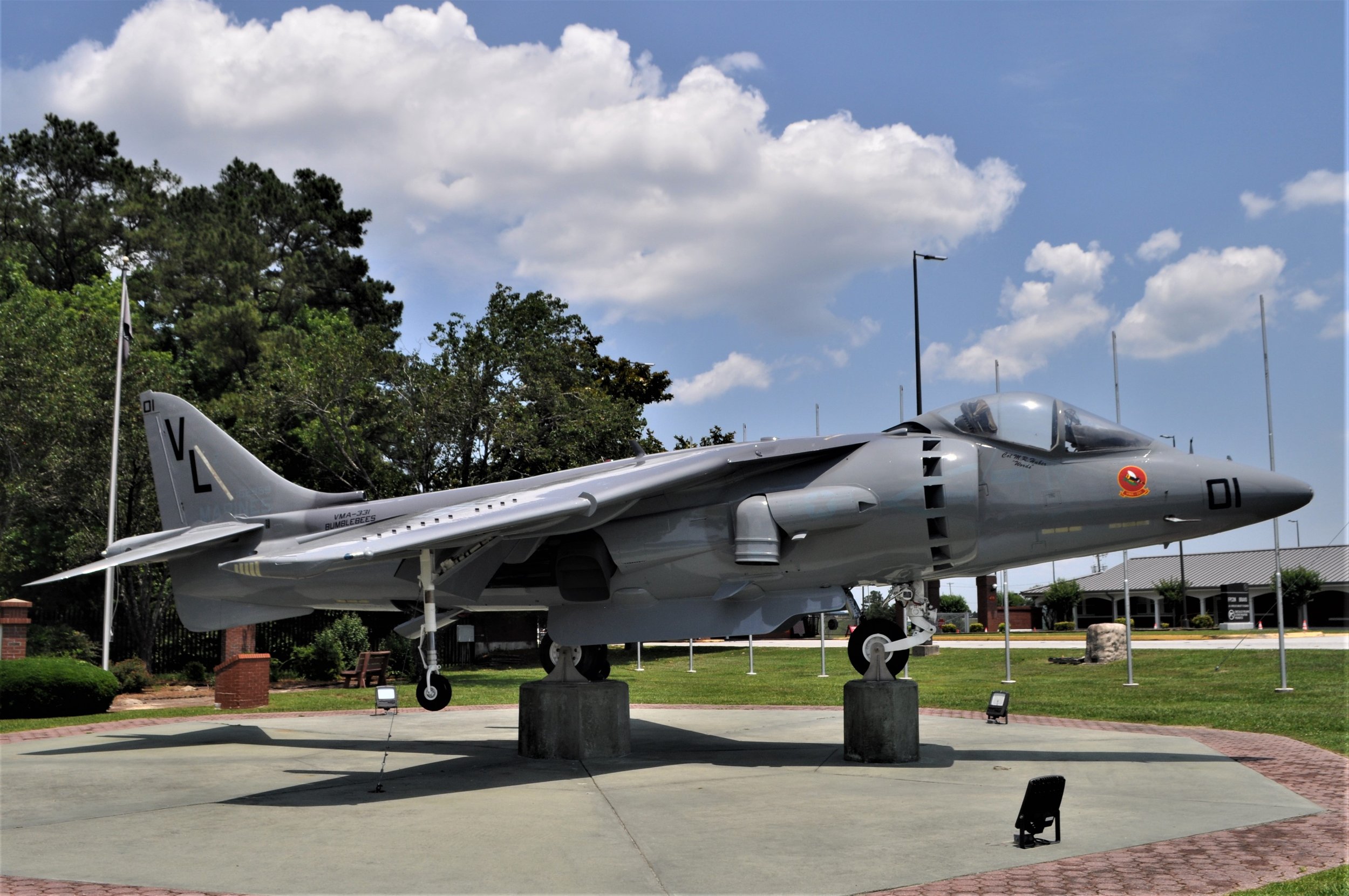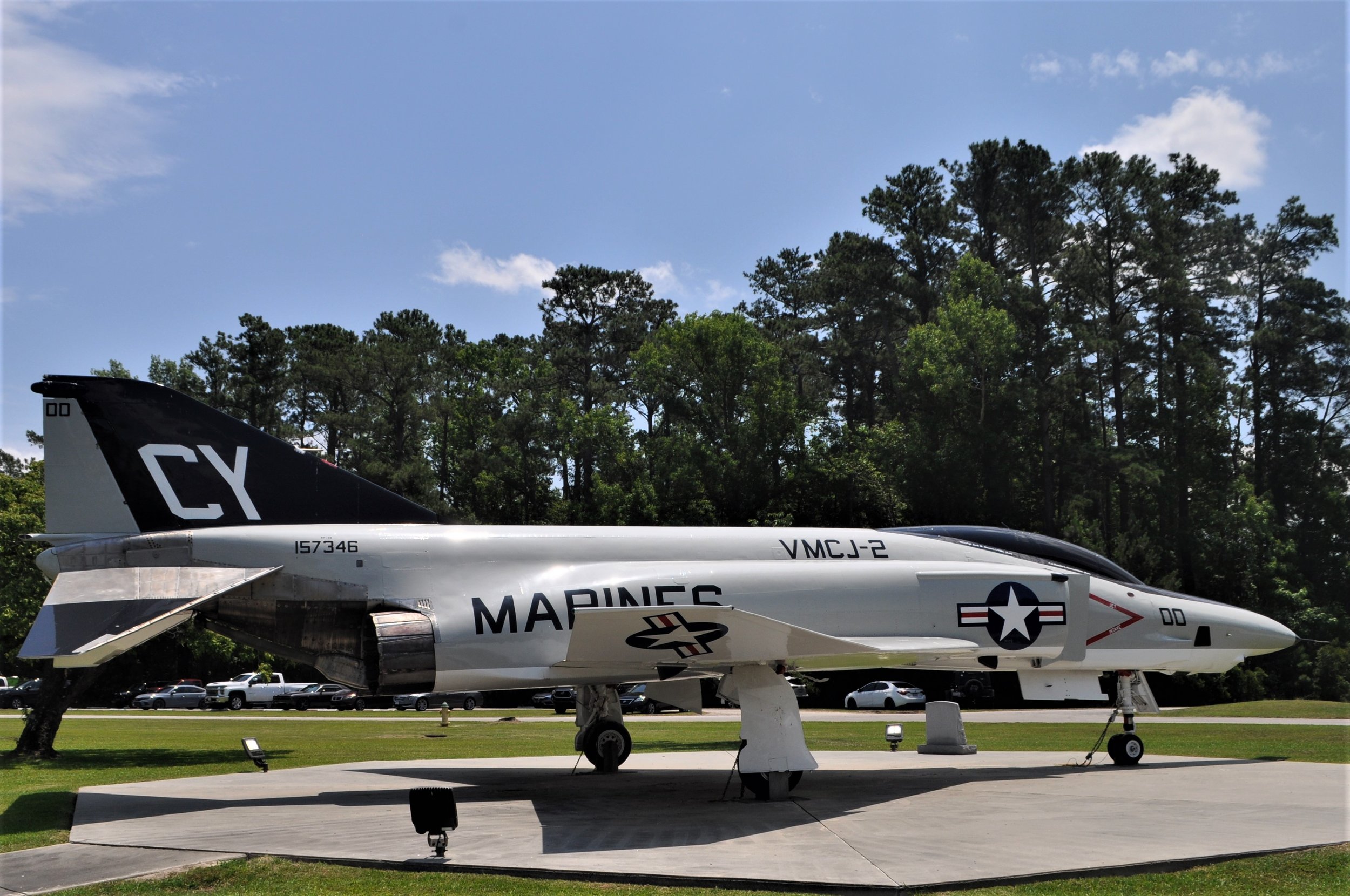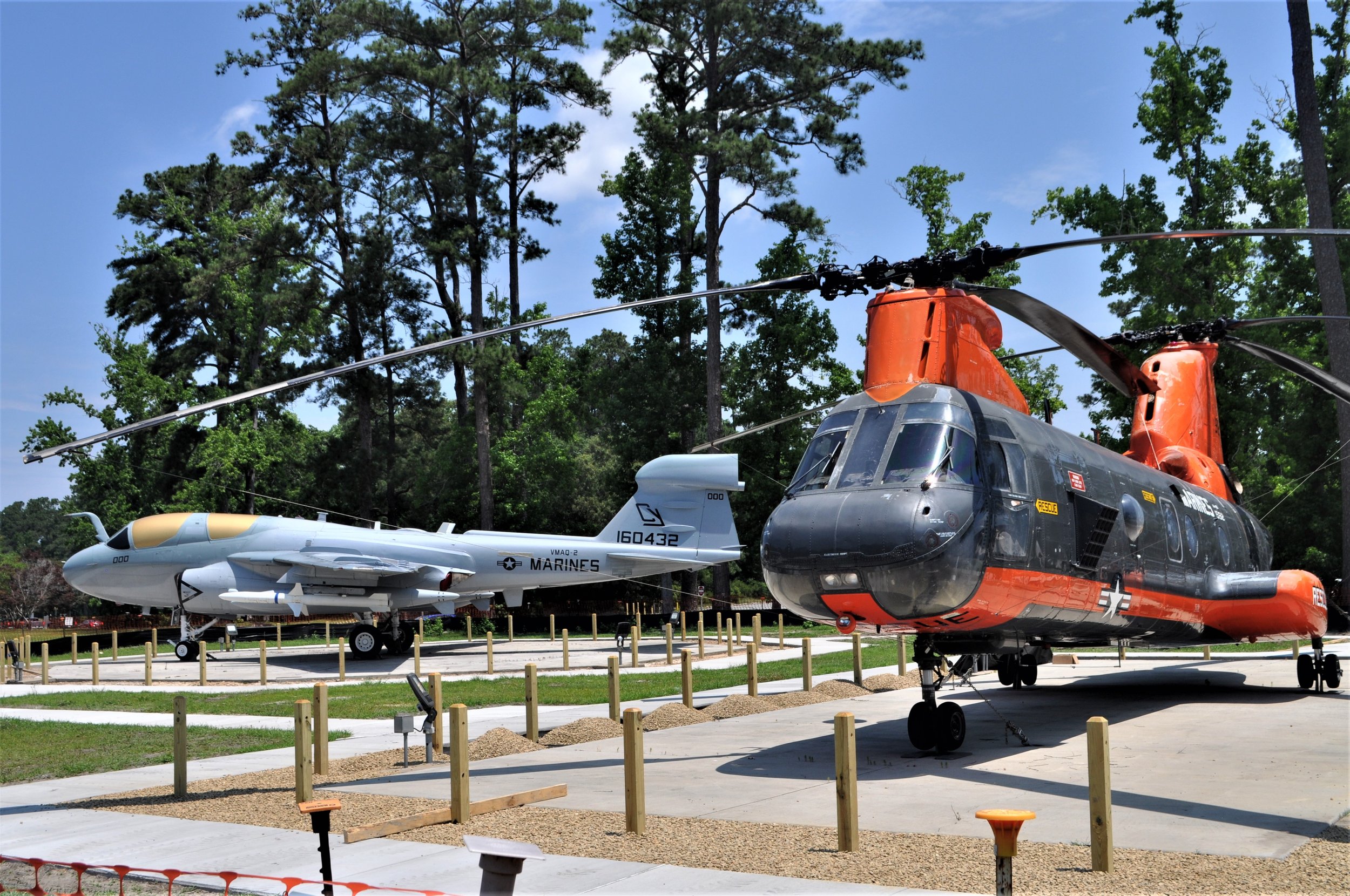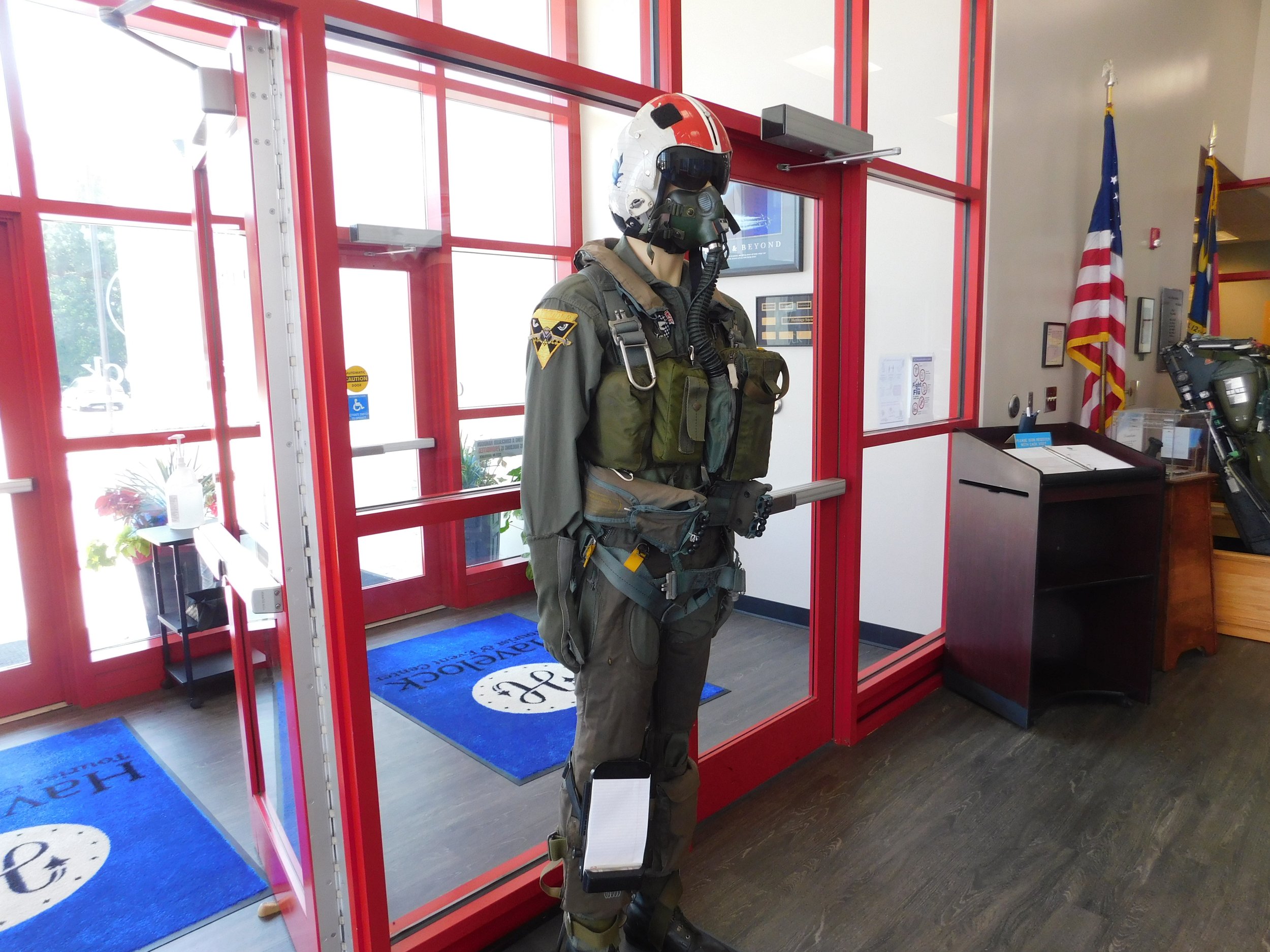The Havelock Tourist & Event Center and MCAS Cherry Point
Issue 35 Visiting the Aviation Exhibits of the Havelock Tourist & Event Center and Marine Corps Air Station Cherry Point June 2022
—————————————————————-
In September of 1999, a hurricane began forming off Cape Verde in North Africa. By September 15th the hurricane, now named Floyd, had reached Category 3 status and was taking aim at the coast of the Carolinas. For several days, evacuations had been underway but millions of people were still in the path of the powerful hurricane. Just after midnight on September 16th, Floyd made landfall at Cape Fear. Receiving the brunt of the storm, North Carolina had 51 of the 85 fatalities attributed to Floyd. Most of the deaths were from fresh water flooding. The Neuse River was one of several rivers in Eastern North Carolina that exceeded 500-year flood levels, cresting over 20 feet above flood stage and flooding Havelock, New Bern, and the surrounding areas. Over the next three days, numerous rescues were made by Navy, Air Force, Coast Guard, and Marine Corps helicopters. One of the units providing search and rescue services was VMR-1 (Marine Transport Squadron One) at Marine Corps Air Station Cherry Point. The unit operated three HH-46E helicopters that were affectionately named “Pedro”. It is estimated that military units performed 1700 aerial rescues during the three days of flooding and the “Pedro” aircraft of VMR-1 performed 399 of those rescues. People were rescued from the tops of buildings, off the tops of vehicles, and from houses or trailers that were about to go underwater.
By 2015, due to military budget cuts, the VMR-1 unit at Cherry Point was retired after 56 years of service. Boeing HH-46E BuNo 151912, which had served in the Pedro squadron for the entire 56 years, is now proudly on display at MCAS Cherry Point.
------------------------------------------------
The Havelock/Cherry Point area is all about Marine Aviation and this blog will visit the Havelock Tourist Center as well as Marine Corps Air Station Cherry Point.
As you approach The Havelock Tourist & Event Center, the first plane you see on display is this Grumman A-6E Intruder. The A-6 was designed in the late 1950s as an all-weather attack aircraft, primarily to replace the Douglas A-1 Skyraider. First flown in 1960, almost 700 Intruders were built between 1962 and 1992. The “E” model was introduced in 1970, with greatly improved electronics, including an inertial navigation system. The A-6E was the most produced Intruder model, accounting for over half of the total. Beginning in 1979, all A-6s were equipped with a small, gyroscopically stabilized turret mounted under the nose of the aircraft. The turret holds a thermal imaging camera (FLIR) which is part of the Target Recognition and Attack Multi-Sensor" (TRAM) system and this A-6E, BuNo 164378, built in 1991 is called a TRAM Intruder.
Inside the Tourist Center there is a TRAM turret on display. As with most of the exhibits in the Center, it is accompanied by a placard that provides a variety of interesting information about the item on display.
Opened in 2002, the Havelock Tourist Center does not call itself a museum, but rather a collection of exhibits. When you visit, though, it definitely feels like a museum, and, combined with Cherry Point MCAS, there are almost 20 aircraft on display.
This McDonnell Douglas RF-4B Phantom II, BuNo 157342, was originally delivered to VMCJ-2 at Cherry Point in 1970. The RF-4B is the reconnaissance version of the Phantom II, with an elongated nose housing forward and side oblique cameras. It also has photoflash cartridges for night photography. Film could be developed in flight and film cassettes would be ejected at low altitude so that aerial intelligence could be studied as rapidly as possible. There was a total of 46 RF-4Bs produced, all serving with the U.S. Marines. They served throughout the Vietnam War.
This Douglas A-4M Skyhawk, BuNo 160024, was delivered to the Marine Corps in 1976. The A-4M was the final model of the A-4, with the last of the 2,960 A-4s built delivered in 1979. The M model was extensively updated from earlier models and was a very capable close air support aircraft. With deliveries of the A-4M beginning as the Vietnam War was starting to wind down, however, it was the only A-4 model (besides the A model) to not see combat.
This A-4 last served with the VMA-131 Diamondbacks, a squadron that traces its roots back to the First Marine Air Squadron founded in 1919. In 1941, they were designated Marine Scout-Bomber Squadron (VMSB) 131 and the squadron served in the Pacific during WW-II, most notably at Guadalcanal. Deactivated after the war, they were re-activated in 1958 as reserve squadron VMF-131. In 1962 the squadron transitioned to A-4s and was redesignated VMA-131, based at NAS New York (Floyd Bennett Field). The squadron later moved to NAS Willow Grove (PA), where it was based until decommissioning in 1998.
This HH-46D, BuNo 150941, is probably the oldest HH-46D on display anywhere. It was delivered in May of 1964, the year the HH-46 was introduced. Using the call sign “Angel One”, this Sea Knight served with VMR-1 at MCAS Beaufort, South Carolina.
During the 1950s, Piasecki Helicopter produced the piston powered H-21 “Flying Banana”, one of the first successful tandem rotor helicopters. By 1958, Piasecki began development of a turbine powered tandem rotor, the model 107. At this time, the company was renamed Vertol and the model 107 became the Vertol CH-46 Sea Knight (becoming Boeing-Vertol in 1960). Manufactured until 1971, 666 of the type were built, serving in the Navy, Air Force, Marines, and with a number of other countries.
Inside the Tourist Center you will find a variety of aviation exhibits ranging from Marine memorabilia to a full-sized plane.
This fully restored ejection seat from a Harrier is a good example of the type of exhibit you will see.
The Universal Propulsion Company S-III-S ejection seat was used on several types of aircraft, but most notably on the AV-8B Harrier II. As describe on the attached placard, it is a 0/0 seat, as the pilot can eject anywhere from 0-600 knots and at any altitude. The first step of an ejection is for string charges to break the canopy. If you look closely, you can see the squiggly lines of the charges on the close up of a Harrier canopy below.
If the canopy charges fail, the top of the seat is equipped with “breakers” that will mechanically break through the canopy. There are a number of events that happen in a short period of time, including a gas-fired inertial reel that ensures that the pilot is upright. An ejection sequence is very complex and it is interesting to see a seat up close.
The Gatling-type 5-barrel GAU-12U 25mm Equalizer Cannon of the Harrier is also well described on the placard. The gun fires at 3,000-4,200 rounds per minute and the design distributes forces over the five barrels, providing extended barrel life. This gun is also used on the AC-130U gunship as well as the LAV-AD armored vehicle.
The entire area, of course, is developed around the Marine Corps Air Station at Cherry Point. Original construction of the base began several months before the attack on Pearl Harbor, and went into overdrive once the U.S. entered WW-II. The development and history of MCAS Cherry Point is well covered in various displays, including an historical timeline.
The Tourist Center is the host to many events, with several meeting rooms available for special events. Impressively displayed above one of the rooms is this 1931 Boeing F-4B-3 pursuit aircraft
First flown in 1928, 586 of the type (Boeing model 99) were built. The -3 version was greatly updated in construction techniques, including a semi-monocoque design. It was powered by an upgraded Pratt and Whitney R- 1340-D Wasp engine. From 1933-1938, the F-4B-3 was flown by two Marine squadrons- VF-9M and VF-10M, both at Quantico, Virginia. There aren’t very many of this type on display and it is great to see one, especially a fully restored one like this.
Suspended in the same room is this RQ-2B drone (UAV). This drone, BuNo 300307, has flown over 1,000 hours. These UAVs flew missions in the Persian Gulf, Somalia, Bosnia, Kosovo and Iraq conflicts. This particular drone was operated by the VMU-2 Night Owls at Cherry Point and last flew in 2005 in Iraq.
There is more than just aviation history in the Havelock area and there are some interesting displays of other history of the region that are also worth browsing.
A pair of General Electric T-58 turboshaft engines powered the HH-46 Sea Knight as well as the Sikorsky SH-3 Sea King and a number of other helicopters. Certified in 1959, it was the first turbine engine certified for helicopter use. The T-58 is light (less than 350 pounds) and very reliable. It still powers the presidential helicopter, Marine One.
The display cases in the Center are well organized and contain a wide variety of exhibits, covering many areas of Marine Aviation.
The Havelock Tourist Center is a great place to visit, with a number of interesting exhibits. It should be noted that all of the aircraft on display here are kept in excellent condition. As we have seen at other museums, it is no easy feat to maintain aircraft that are displayed outside and subject to the weather 24/7.
———————————————————
It is a short drive from the Havelock Tourist Center to the Main Gate of Marine Corps Air Base Cherry Point, and there are two Harriers on display on the way.
This AV-8A, BuNo 158976, entered service in 1974 and served with VMA-513 and VMA-231. It was retired in 1986 and dedicated here in front of the Havelock Police Station in November of that year. It stands to honor all military and civilian employees, past, present, and future who have worked to support the area.
Displayed in front of the main gate of Cherry Point is another Harrier, this one from the VMA-331 “Bumblebees”. The squadron was formed (as VMSB-331) at Cherry Point in January, 1943. Flying SBD Dauntless dive bombers, they served in the South Pacific during WW-II, notably in the Gilbert and Marshall Islands. Like other Marine squadrons we have seen, VMSB-331 was quickly decommissioned after WW-II, only to be reactivated (as VMA-331) in 1952. The squadron served during the Bay of Pigs and Desert Storm before again being deactivated in 1992.
I have mentioned that the aircraft on display in Havelock/Cherry Point are kept in excellent condition, and this Harrier exemplifies this- it is in pristine condition. What I liked about this AV-8, is that it is displayed in the STOL landing configuration. As you walk around the plane, you can see the various thrust vectoring nozzles as it is about to touch down (the only thing missing is the noise- which I am sure was extraordinary!).
Another aspect of the displays is that they are all accessible- it always adds to the experience when you are able to get up close to see the details of the aircraft.
———————————————————————-
Marine Corps Air Station Cherry Point
Note- there are five aircraft on display on Marine Corps Air Station Cherry Point. These aircraft are not visible from public areas and you will need to be with a sponsor to enter the base. It was an easy process to stop at the main gate and get a pass, but you must be accompanied by an active duty or retired member.
When I started to research the Havelock/Cherry Point area, I read in several places that there was C-117D (Super DC-3) on display at Cherry Point. I flew the C-117 on active duty and I was looking forward to seeing one on display. I was disappointed to not find the plane on the base and I later had correspondence with Bill Sidoran, the Cherry Point historian. He could not find any reference to a C-117 ever being on display. So, the internet references (and photos) of the C-117 were not accurate- who knew! In any event, I had already written up this little story about a C-117 flight. As this flight was from NAS Patuxent River, the site of last month’s blog to MCAS Cherry Point, I thought I would include the story anyway. If any reader has any information about a C-117 at Cherry Point, please let me know.
Douglas C-117D Super DC-3 Photo: Richard Vandervord
“Pax tower, Navy 17119 ready on 24”.
The venerable C-117D taxied into position for takeoff from NAS Patuxent River. The 15 passengers, all student flight surgeons, were in high spirits. They were heading home to Pensacola on the final day of a week-long road trip and the C-117 had been their transport to half a dozen Navy bases. There was still one stop to make, at Marine Corps Air Station Cherry Point. The weather was typical for early summer on the East Coast, with thunderstorms popping up all over.
The short flight along the coast had been in the clear, but approaching Cherry Point, a fairly large storm could be seen to the Southeast. The C-117 had no on-board radar, so weather avoidance came from ATC but mainly from the crew’s own eyes. The aircraft commander, flying right seat on this leg, fished out the approach plates for Cherry Point and selected the ADF (Automatic Direction Finding) approach to runway 14L. The year was 1976 and NDB (Non-Directional Beacon) approaches were still widely in use. This would be good practice for the inexperienced co-pilot in the left seat. The co-pilot took one look at the plate and handed it back, shaking his head no.
“What’s the problem?”
“I don’t do ADF approaches.”
“It would be good practice.”
“Nope.”
The aircraft commander didn’t feel like arguing and started planning for a GCA (Ground Controlled Approach). Ten minutes later, as the crew was getting ready to switch to Cherry Point approach control, Atlanta Center called.
“Navy 119, be advised that Cherry Point tower has had a lightning strike and all their radios are out. Standby for holding instructions.”
The aircraft commander looked at the ADF needles and they still seemed to be pointing accurately. He flipped up the audio switches and listened to the Morse Code identifier. Both receivers were coming in loud and clear.
“Center, be advised, Navy 119 is receiving the Cherry Point beacon loud and clear.”
“Roger, Navy 17119 is cleared for the NDB approach runway 14 left. Frequency change your discretion.”
The aircraft commander concealed a smirk as he handed the NDB chart back to the co-pilot, who had no choice but to fly the approach. The pilot tried contacting Cherry Point tower and got no reply. On short final, probably for the only time in his career, he saw a green light pointed at him from the tower. Cleared to land.
Note- I know this sounds like a made-up scenario, but it isn’t. I was the aircraft commander. Within the bounds of memory from that long ago, it happened just like that. The fact that it was on a flight from the field in last month’s blog (PAX River) to the one in this month’s is just an interesting coincidence. The flight from Cherry Point to Pensacola later in the day was interesting too- a story for another time.
Author, 1976 Photo, Wayne Bevis
There are five aircraft on display at Cherry Point. There are four exhibited in a display area near the main gate, the MCAS Cherry Point Historic Air Park, and the fifth, this RF-4B Phantom II, BuNo 157346, is displayed in front of the base golf course.
When we visited, the main display was still under construction, with just these two aircraft in place, an EA-6B Prowler, BuNo 160432, of VMAQ-2 and the HH-46 “Pedro” that we discussed earlier.
Photo courtesy of Bill Sidoran
This Intruder, a Grumman EA-6A 'Electric' Intruder, BuNo 147865, of VMCJ-2 was added after our visit. The EA-6A was the first electronic version of the Intruder, basically an interim aircraft until the EA-6B was developed. There were 27 two-seat A models produced, 12 of which were converted from standard A-6s. The type was mostly retired by the 1970s, as four-seat B models became available.
Photo courtesy of Bill Sidoran
The other aircraft recently added is this AV-8B Night Attack, BuNo 163863. The Night Attack Harrier is an improved version with FLIR, an upgraded cockpit with night-vision goggle compatibility, as well as a more powerful Rolls Royce Pegasus engine. Most current Harriers were built or upgraded to this standard.
If you are in the area of coastal North Carolina, a visit to Havelock and the area around MCAS Cherry Point is well worth a visit.
-----------------------------------------------
Many thanks to Richard Hazlett, Havelock Aviation Curator, Caitlin Gibson of the Havelock Tourist Center, and Bill Sidoran Cherry Point Historian, for their assistance in my research.
A few other “thanks” that I should add to all of my blogs. My son Mark and his wife Taylor helped me do the initial design of the blog and website; my son Eric is always helpful with technical questions; my son AJ not only offers technical advice, but is very generous with offering rides to museums in his Baron; and my daughter-in-law Angela often has valuable input and suggestions. My brother Mike edits the blog each month with very valuable input. Above all, my wife Sheri provides support and encouragement and often accompanies me on museum visits. A huge thanks to everyone!
------------------------------------
To learn about what to do in the local area, museum hours and costs as well as books to read and other interesting odds and ends, keep reading! At the end you will find a photo gallery of the entire museum.
PLANNING YOUR VISIT
(Havelock Tourist Center)
Monday-Friday 8AM- 5PM
Saturday 10AM-5PM
Closed Sunday
There is no admission charge.
FLYING IN
Coastal Carolina Regional airport (KEWN) in New Bern is about 20 minutes from Cherry Point. It has a 6,400’ runway (4/22) and a 4,000’ runway (14/32). ILS and RNAV approaches are available and Tidewater Air Services is a full-service FBO.
Public Domain Photo, Courtesy USMC
Although Cherry Point is not open to non-military flights, I wanted to point out that it has the best runway set-up ever. They have two parallel runways (14/32 L & R and 05/23 L & R) but they aren’t next to each other like most airports, they are staggered. The center of the airport is a large paved ramp. Because of this, no matter what runway you land on, you taxi to the end and you are at the terminal. No matter what runway you are departing on, as soon as you taxi- you are at the end of the runway. In addition, the runways are 8,000-9,000’ long, but if you have a problem and can’t get stopped, you simply cross the ramp and sidestep to the parallel runway- making the runways effectively 17,000’ long. It’s a perfect airport! I’ve never seen another one like it, but it does occupy a lot of real estate.
By the way, the EA-6A flying over the airport is the one now on display at the MCAS Cherry Point Historic Air Park.
LOCAL ATTRACTIONS
The facility where the exhibits are is the Havelock Tourist Center so naturally, they had some suggestions for what else to see in the area!
9/11 Memorial, Kayak on Slocum Creek, Walter B. Jones Park Imagination Station, Iron Clad Axe Throwing, try your hand at Archery at Archery Academy, legally break some stuff at the Unleash Rage Room, play Pickle Ball at the Havelock Recreation Center, hike Beady Loop Trail, stroll through the Havelock Mall, take the Cherry Branch Ferry to Minnesott Beach, visit the Civil War Memorial Park in Newport, NC
Thanks to Caitlin Gibson for that great list as well as these tips where to eat!
WHERE TO EAT
Start your morning at Ziggy’s Cafe for a delicious breakfast! Refresh yourself with a tea or shake at Craze Nutrition. For lunch enjoy Verduzco’s Wrapz Soups & Salads - Everything is made to order. Their food is fresh and delicious. Think Panera Bread but homemade. La Casa del Patron is a must for dinner- their complimentary bean dip is amazing and the chimichanga is perfection! Finish this night with ANYTHING from Carolina’s Cupcakes. Not a cupcake fan? No worries, Carolina’s Cupcakes serves everything from ice cream to scones. They’ll have something for you!
By far the most complete list in the series- thanks again Caitlin!
SUGGESTED READING
I recently watched a You Tube video about a 1962 ditching of a Lockheed Constellation in the North Atlantic. The video was developed from the book- Tiger in the Sea: The Ditching of Flying Tiger 923 and the Desperate Struggle for Survival by Eric Lindner. Emergency procedures, Crew coordination, decision making, and survival, this is a gripping true story and well worth a read.
MUSEUM WEBSITE
UP NEXT
A tour of the Dare County Airport Museum on the 80th anniversary of the opening of the airport.
MUSEUMS ARE WHERE YOU FIND THEM
This segment is dedicated to finding interesting aviation artifacts that are in public view- but not in an aviation museum. If you see one send a photo!
Photo: Megan Allen
Reader Doug Campbell recently sent this photo of a monument in St Petersburg Florida. It stands to commemorate the world’s first airline flight, which took place on January 1, 1914, from St. Pete to Tampa. Abe Pheil, who paid $400 for the trip, was the world’s first airline passenger. Phiel and the pilot, Tony Jannus, flew across Tampa Bay and landed in Tampa. There Phiel signed some documents for his wholesale company. The pair then flew back to St. Pete, with the entire trip taking about an hour and a half. At the time, the one-way trip from St. Petersburg to Tampa took about two hours by boat, 12 hours by train, or 20 hours by car. The Benoist Aircraft Company flew the route twice a day for the next three months, until traffic dropped off as Florida snow birds returned north at the end of the season.
Little remembered today, Tony Jannus was not only the world’s first airline pilot but was the first pilot to test the airborne use of machine guns and, in 1912, carried Capt. Albert Berry aloft to make the first parachute jump from a plane.
Thanks Doug!
GALLERY
Click any photo to enlarge
Issue 35, Copyright©2022, Pilot House Publishing, LLC. All rights reserved. Except where noted, all photos by the author.
